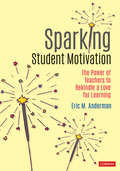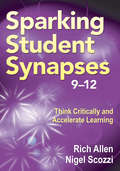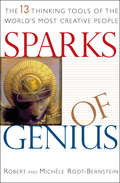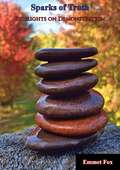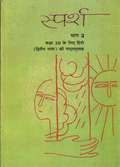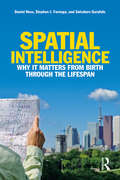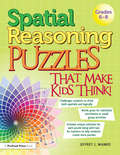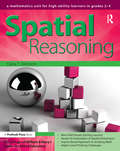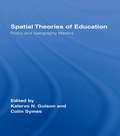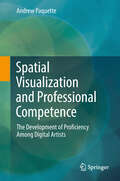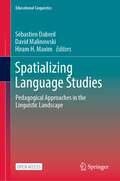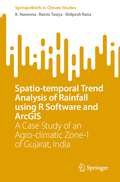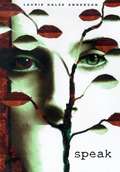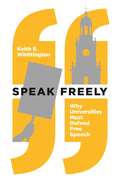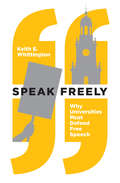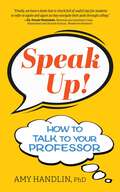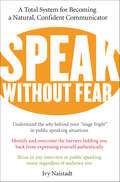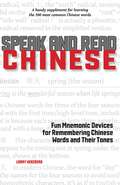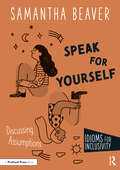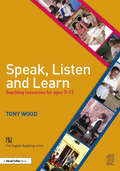- Table View
- List View
Sparking Student Motivation: The Power of Teachers to Rekindle a Love for Learning (Corwin Teaching Essentials)
by Eric M. AndermanBe the change that lights the learning fire. Discover how you, as a classroom teacher, can generate enthusiasm, confidence, and joy in your students that will affect their learning and lives. Delve into the what, and why of motivation and how it affects learning. Then, learn how to spark motivation using practical, research-informed strategies that address how to ? Hone student grouping, rewards, technology, and competition for positive impact ? Confront and disarm testing conflicts to make assessments a pleasant student experience ? Examine and empower teacher–student relationships ? Rethink rules and procedures to improve behavioral outcomes
Sparking Student Synapses, Grades 9–12: Think Critically and Accelerate Learning
by Richard Allen Nigel ScozziEngaging methods for teaching 21st-century skills Today’s students must be able to collaborate, innovate, and think critically to solve real-world problems. As content demands increase, how can teachers make time to teach these advanced skills? Find practical solutions in the story of how master teacher Nigel Scozzi used Rich Allen’s Green Light strategies to teach content in a memorable and efficient way. Backed by research, this practical guide provides secondary teachers with tried and trusted lesson plans in multiple subjects that: Engage students Accelerate learning Encourage critical thinking Improve test results ·
Sparks of Genius: The 13 Thinking Tools of the World's Most Creative People
by Robert Root-Bernstein Michèle Root-BernsteinDiscover the cognitive tools that lead to creative thinking and problem-solving with this &“well-written and easy-to-follow&” guide (Library Journal). Explore the &“thinking tools&” of extraordinary people, from Albert Einstein and Jane Goodall to Mozart and Virginia Woolf, and learn how you can practice the same imaginative skills to become your creative best. With engaging narratives and examples, Robert and Michèle Root-Bernstein investigate cognitive tools such as observing, recognizing patterns, modeling, playing, and more. Sparks of Genius is &“a clever, detailed and demanding fitness program for the creative mind&” and a groundbreaking guidebook for anyone interested in imaginative thinking, lifelong learning, and transdisciplinary education (Kirkus Reviews). &“How different the painter at the easel and the physicist in the laboratory! Yet the Root-Bernsteins recognize the deep-down similarity of all creative thinking, whether in art or science. They demonstrate this similarity by comparing the accounts that various pioneers and inventors have left of their own creative processes: for Picasso just as for Einstein, for Klee just as for Feynman, the creative impulse always begins in vision, in emotion, in intuition. . . . With a lavishly illustrated chapter devoted to each tool, readers quickly realize just how far the imagination can stretch.&” —Booklist &“A powerful book . . . Sparks of Genius presents radically different ways of approaching problems.&” —American Scientist
Sparks of Truth; Sidelights on Demonstration
by Emmet FoxThe influence of Emmet Fox in the spread of New Thought ideas lies not simply in the large number of his readers, but in the fact that he is so widely read my ministers of all denominations. This collection of lectures contains easily accessible help for daily problems, practical or emotional. The short lectures are intended to instruct the reader in basic spiritual truth, and to furnish material for short meditations. They were published once a week over a number of years. The subjects are usually handled in a light and amusing style, and often deal with familiar incidents in everyday life. Lectures Include: Take it Easy, An All in Policy, Saluting the Christ in Him, Blessing and Cursing, Stand by for Quarantine, The Will of God, Spreading the Truth, The Dove, Satan Gets Away with It, What is Scientific Prayer, The Bible Unveiled, You are a Mental Being, God's Hour, God in Business, Worm Gets Ideas, and others.
Sparsh Bhag 2 class 10 - NCERT: स्पर्श भाग 2 कक्षा 10 - एनसीईआरटी
by Rashtriy Shaikshik Anusandhan Aur Prashikshan Parishadस्पर्श भाग 2 10वीं कक्षा का राष्ट्रीय शैक्षिक अनुसंधान और प्रशिक्षण परिषद् ने पुस्तक हिंदी भाषा में प्रकाशित किया गया है, प्रस्तुत पाठ्यपुस्तक में गद्य की यथासंभव विविध विधाएँ संकलित करने का प्रयास किया गया है। इन पाठों द्वारा विद्यार्थियों को वैचारिक और ललित निबंधों के अतिरिक्त संस्मरण, व्यंग्य, कहानी, फ़िल्म के यादगार क्षणों को अभिव्यक्ति प्रदान करने वाले सजीव, सरस एवं पाठक को मंत्रमुग्ध करने वाली शैली में वर्णित विवरणों का सामान्य परिचय मिल सकेगा। साथ ही इस पाठ्यपुस्तक में लोककथा और एकांकी को भी स्थान दिया गया है।
Spatial Agency: Other Ways of Doing Architecture
by Nishat Awan Tatjana Schneider Jeremy TillThis book offers the first comprehensive overview of alternative approaches to architectural practice. At a time when many commentators are noting that alternative and richer approaches to architectural practice are required if the profession is to flourish, this book provides multiple examples from across the globe of how this has been achieved and how it might be achieved in the future. Particularly pertinent in the current economic climate, this book offers the reader new approaches to architectural practice in a changing world. It makes essential reading for any architect, aspiring or practicing.
Spatial Citizenship Education: Citizenship through Geography
by Sarah Witham Bednarz Euikyung E. ShinSpatial Citizenship Education is an innovative exploration of ways to engage and promote citizenship through a deeper understanding of spatial and geographic perspectives. The authors propose that recognizing the relationship between space and citizenry enables productive and positive engagement with important societal issues such as equity, justice, and environmental stewardship. By providing a historical overview of geography’s contribution to citizenship education, including progress made and challenges faced by educational reform movements, this collection shows how geography can contribute to a new type of citizen—one with an enhanced understanding of the world as seen through the key concepts of geography: space, place, scale, power, and human-environment relationships. Through a theoretical explanation of key citizenship ideas, and by providing practical, classroom-based teaching tools, this volume will be essential for geography education researchers and social studies educators alike.
Spatial Intelligence: Why It Matters from Birth through the Lifespan
by Daniel Ness Salvatore G. Garofalo Stephen J. FarengaSpatial Intelligence examines public and professional conceptions of the relationships between thinking about spatial attributes and active engagement in spatially related constructions and designs. Even though children’s and adolescents’ spatial propensities in constructive activities parallel the skills needed by professionals in both established and emerging fields, spatial education is often missing from K–12 curricula and is easily impeded by teachers, parents, or other individuals who do not provide contexts in formalized settings, such as schools, to nurture its potential. This book bridges the gap by linking the natural spatial inclinations, interests, and proclivities of individuals from a variety of cultures with professional training and expertise in engineering, architecture, science, and mathematics. Educators will be better able to achieve the skills and awareness necessary to provide children and young adults with the vital opportunities inherent in spatial education.
Spatial Reasoning Puzzles That Make Kids Think!: Grades 6-8
by Jeffrey J. WankoSpatial Reasoning Puzzles That Make Kids Think! engages even the most reluctant math learner. In this fun and challenging book, students must conquer four types of logical and spatial reasoning puzzles (Slitherlink, Hashiwokakero, Masyu, and Yajilin). The rules for each type of puzzle are very different, but easy to understand. The challenge is for students to apply their critical thinking skills to new situations and develop new strategies for solving each puzzle. Teacher support is provided for solving the puzzles and also for helping students to create puzzles of their own. Students will be begging for more of these unique spatial reasoning puzzles!Grades 6-8
Spatial Reasoning in the Early Years: Principles, Assertions, and Speculations
by Brent Davis Spatial Reasoning Study GroupOver the past several years, "spatial reasoning" has gained renewed prominence among mathematics educators, as spatial skills are proving to be not just essential to mathematical understanding but also strong predictors of future success beyond the classroom in fields such as science, technology, and engineering. By exploring both primary and emergent dimensions, Spatial Reasoning in the Early Years helps define the concept of spatial reasoning and provides compelling evidence of the need for a clear focus within early education specifically. The authors review the research, look across current theories, and investigate implications for contemporary school mathematics pedagogy as they identify areas of inquiry necessary to bring a stronger spatial reasoning emphasis into the classroom. The book contains many classroom- or workshop-based vignettes, highlighting the complexity of spatial reasoning in educational practice, providing an in-depth analysis of spatial reasoning as it applies to classroom practice, and offering new ways of framing lessons to help young students hone their spatial reasoning abilities. The book concludes with a forward-looking agenda that contributes to developing a greater understanding of the role spatial reasoning plays in educational contexts and beyond. Supported by plentiful visual representations, Spatial Reasoning in the Early Years skillfully integrates the conceptual and the concrete, making this text a dynamic and accessible resource.
Spatial Reasoning: A Mathematics Unit for High-Ability Learners in Grades 2-4
by Dana T. JohnsonSpark the visual learning of students in grades 2-4 with Spatial Reasoning, a mathematics unit for high-ability learners. Gifted students demonstrate an advanced aptitude for spatial reasoning at early ages, and they require more complex lessons than what the standard curriculum provides. This field-tested unit approaches spatial reasoning through one-dimensional (1-D), two-dimensional (2-D), and three-dimensional (3-D) tasks that will engage students.The lessons in this unit are differentiated for gifted learners, and they are supported by hands-on extension activities that extend spatial concepts beyond the classroom. The skills learned throughout this unit will lay the foundation of spatial reasoning that will prepare students for middle school and beyond.Spatial Reasoning was developed by the Center for Gifted Education at The College of William and Mary.Grades 2-4
Spatial Theories of Education: Policy and Geography Matters (Routledge Research in Education #Vol. 9)
by Kalervo N. Gulson Colin SymesThis collection of original work, within the sociology of education, draws on the 'spatial turn' in contemporary social theory. The premise of this book is that drawing on theories of space allows for a more sophisticated understanding of the competing rationalities underlying educational policy change, social inequality and cultural practices. The contributors work a spatial dimension into the consideration of educational phenomena and illustrate its explanatory potential in a range of domains: urban renewal, globalisation, race, markets and school choice, suburbanisation, regional and rural settings, and youth and student culture.
Spatial Visualization and Professional Competence: The Development Of Proficiency Among Digital Artists
by Andrew PaquetteThe computer graphics (CG) industry is an attractive field for undergraduate students, but employers often find that graduates of CG art programmes are not proficient. The result is that many positions are left vacant, despite large numbers of job applicants. This book investigates how student CG artists develop proficiency. The subject is important to the rapidly growing number of educators in this sector, employers of graduates, and students who intend to develop proficiency for the purpose of obtaining employment. Educators will see why teaching software-oriented knowledge to students does not lead to proficiency, but that the development of problem-solving and visualisation skills do. This book follows a narrow focus, as students develop proficiency in a cognitively challenging task known as ‘NURBS modelling’. This task was chosen due to an observed relationship between students who succeeded in the task, and students who successfully obtained employment after graduation. In the study this is based on, readers will be shown that knowledge-based explanations for the development of proficiency do not adequately account for proficiency or expertise in this field, where visualisation has been observed to develop suddenly rather than over an extended period of time. This is an unusual but not unique observation. Other studies have shown rapid development of proficiency and expertise in certain professions, such as among telegraph operators, composers and chess players. Based on these observations, the book argues that threshold concepts play a key role in the development of expertise among CG artists.
Spatializing Language Studies: Pedagogical Approaches in the Linguistic Landscape (Educational Linguistics #62)
by David Malinowski Hiram H. Maxim Sébastien DubreilThis open access volume offers valuable new perspectives on the question of how mobility, locatedness and immersion in the physical world can enhance second language teaching and learning. It does so through a diverse array of empirical studies of language, literacy, and culture learning in the linguistic landscape of visible and audible public discourse. Written from conceptually rich and disciplinarily varied perspectives, its ten chapters address methodological and practical problems of relating language learning to the lived and rapidly changing places of the late modern world. Whether it is within the four walls of a school, in a nearby multilingual neighborhood, in a virtual telecollaborative space, or in any other location where languages may be learned, this volume highlights different configurations of learning spaces, the leveraging of real-world places for critical learning, and ways to productively ‘dislocate’ language learners from preconceived notions and standardized experiences. Together, these elements create conditions for a language and literacy pedagogy that can be said to be robustly spatialized: linguistically and culturally complex, geographically situated, historically informed, dialogically realized, and socially engaged.
Spatio-temporal Trend Analysis of Rainfall using R Software and ArcGIS: A Case Study of an Agro-climatic Zone-1 of Gujarat, India (SpringerBriefs in Climate Studies)
by K. Naveena Ramiz Tasiya Shilpesh RanaThis book aims to provide an advanced R software approach that can carry out rainfall trend analysis using Mann-Kendall and Sen’s slope estimator tests. The research study follows a systematic approach while utilizing R software as it can greatly facilitate the analysis of rainfall trends. About 30 stations located in the study area and 41 to 50 years’ time series were selected for the purpose of analysis. The data for the research was collected from the State Water Data Centre (SWDC) in Gujarat, Indian Meteorological Department (IMD) in Pune, DAAC (NASA), and ESRI. Cluster analysis has been performed to analyze the variability of the mean rainfall. The stations have been divided into 2 clusters with 17 and 13 stations in each cluster which significantly differ from each other. This book is aimed at researchers, scientists and government organizations working in the field of climate change.
Speak
by Laurie Halse Anderson<P>I am clanless. I wasted the last weeks of August watching bad cartoons. I didn't go to the mall, the lake, or the pool, or answer the phone. I have entered high school with the wrong hair, the wrong clothes, the wrong attitude. And I don't have anyone to sit with. <P>From her first moment at Merryweather High, Melinda Sordino knows she's an outcast. She busted an end-of-summer party by calling the cops-a major infraction in high-school society-so her old friends won't talk to her, and people she doesn't know glare at her. <P>She retreats into her head, where the lies and hypocrisies of high school stand in stark relief to her own silence, making her all the more mute. <P>But it's not so comfortable in her head, either-there's something banging around in there that she doesn't want to think about. Try as she might to it won't go away, until there is a particular confrontation. <P>Once that happens, she can't be silent-she must speak the truth. In this powerful novel, an utterly believable, bitterly ironic heroine speaks for many a disenfranchised teenager while learning that, although it's hard to speak up for yourself, keeping your mouth shut is worse.
Speak (Hampton-brown Edge Series)
by National Geographic Learning National Geographic LearningEveryone at school hates Melinda Sordino because of something that happened during the summer, but nobody knows the truth. Melinda wants to erase that memory from her mind, but then something happens that makes her end her silence and speak.
Speak Freely: Why Universities Must Defend Free Speech (New Forum Bks. #61)
by Keith E. WhittingtonWhy colleges and universities live or die by free speechFree speech is under attack at colleges and universities today, as critics on and off campus challenge the value of freewheeling debate. In Speak Freely, Keith Whittington argues that universities must protect and encourage vigorous free speech because it goes to the heart of their mission to foster freedom of thought, ideological diversity, and tolerance. Examining hot-button issues such as trigger warnings, safe spaces, hate speech, disruptive protests, speaker disinvitations, and the use of social media by faculty, Speak Freely describes the dangers of empowering campus censors to limit speech and enforce orthodoxy. It explains why universities must make space for voices from both the Left and Right. And it points out how better understanding why the university lives or dies by free speech can help guide students, faculty, administrators, and alumni when faced with unpopular, hateful, or dangerous speech. Timely and vitally important, Speak Freely shows why universities can succeed only by fostering more free speech, more free thought—and a greater tolerance for both.
Speak Freely: Why Universities Must Defend Free Speech (New Forum Books #61)
by Keith E. WhittingtonWhy free speech is the lifeblood of colleges and universitiesFree speech is under attack at colleges and universities today, with critics on and off campus challenging the value of open inquiry and freewheeling intellectual debate. Too often speakers are shouted down, professors are threatened, and classes are disrupted. In Speak Freely, Keith Whittington argues that universities must protect and encourage free speech because vigorous free speech is the lifeblood of the university. Without free speech, a university cannot fulfill its most basic, fundamental, and essential purposes, including fostering freedom of thought, ideological diversity, and tolerance. Examining such hot-button issues as trigger warnings, safe spaces, hate speech, disruptive protests, speaker disinvitations, the use of social media by faculty, and academic politics, Speak Freely describes the dangers of empowering campus censors to limit speech and enforce orthodoxy. It explains why free speech and civil discourse are at the heart of the university’s mission of creating and nurturing an open and diverse community dedicated to learning. It shows why universities must make space for voices from both the left and right. And it points out how better understanding why the university lives or dies by free speech can help guide everyone—including students, faculty, administrators, and alumni—when faced with difficult challenges such as unpopular, hateful, or dangerous speech. Timely and vitally important, Speak Freely demonstrates why universities can succeed only by fostering more free speech, more free thought—and a greater tolerance for both.
Speak Up
by Miranda PaulWhen something really matters, one voice can make a difference. This spirited, vibrant picture book celebrates diversity and encourages kids to speak up, unite with others, and take action when they see something that needs to be fixed.Join a diverse group of kids on a busy school day as they discover so many different ways to speak up and make their voices heard! From shouting out gratitude for a special treat to challenging a rule that isn&’t fair, these young students show that simple, everyday actions can help people and make the world a better place.
Speak Up!: How to Talk to Your Professor
by Amy HandlinSpeak Up! teaches students how and why they should reach out and connect with their professors. Author Amy Handlin provides thoughtful and strategic advice based on her 25+ years of teaching and advising experience. Students know it&’s important to connect with their professors, since those relationships will pay off immediately and throughout their academic careers. Approaching professors can be intimidating, but this step-by-step guide prepares college and graduate students to advocate for themselves and develop the skills they need to build connections with professors. Speak Up! includes cut-and-paste sample emails, scripts for in-person meetings, and tips for navigating tricky situations.
Speak Without Fear: A Total System for Becoming a Natural, Confident Communicator
by Ivy NaistadtFor many of us, public speaking is at best a chore marked by great anxiety and at worst a potential career stopper. Ours is a time when the ability to communicate in front of individuals or groups in all types of business and other situations is becoming paramount. Speak Without Fear offers a unique, practical process for combating the stage fright that plagues us every day in these situations. Unlike other books on public speaking, Speak Without Fear goes beyond the external techniques, such as how to breathe properly and keep eye contact, to delve deeply into the reason for your performance anxiety. It gets to the root of what's giving you the sweats so you can identify what's in the way and work through it to communicate naturally and comfortably before audiences of any size. Ivy Naistadt's easy-to-follow, step-by-step program will help you: Identify the degree and type of your nervousness Pinpoint the incidents and issues that, directly or indirectly, cause you fear and loathing in the spotlightDevelop and master a technique for over-coming your anxiety that's adaptable to your level of experience and needUse your new skills to shine in a variety of situations -- whether speech making, interviewing, auditioning, or presenting No matter how anxious you are about going before an audience -- any audience, whether it's 1 or 1,000 -- Speak Without Fear will give you the tools to speak powerfully and persuasively.
Speak and Read Chinese: Fun Mnemonic Devices for Remembering Chinese Words and Their Tones
by Larry HerzbergFrom one of the authors of Basic Patterns of Chinese Grammar comes Speak and Read Chinese, a simple, fun guide that helps language learners remember essential Chinese characters.Students and teachers rate character pronunciation and tones the two most difficult aspects of learning Chinese. This book addresses this issue by organizing easy pronunciation and tone memorization tricks for the three hundred most basic characters in popular textbook series like Integrated Chinese and New Practical Chinese Reader.Larry Herzberg did his Master's and PhD work in Chinese Language and Literature at Indiana University. He founded Chinese-language programs at two colleges and has been teaching for thirty years.
Speak for Yourself: Discussing Assumptions (Idioms for Inclusivity)
by Samantha BeaverTo get the complete Idioms for Inclusivity experience, this book can be purchased alongside four others as a set, Idioms for Inclusivity: Fostering Belonging with Language, 978-1-032-28635-8. Informed by sociolinguistic research, yet written accessibly, Speak for Yourself challenges readers to investigate the concept of assumptions as it relates to both language-use and inclusivity. This engaging and delightfully illustrated book invites students to engage with concepts such as: the cultural meaning of the idiom "speak for yourself" and how it can act as a helpful warning against harmful assumptions, Presuppositions – a concept developed by linguists to research and understand assumptions in language, why the expectation to "speak for yourself" can make someone feel excluded, and how understanding the way language works can help us learn to be more inclusive. Featuring practical inclusivity tips related to integrating learning into daily conversations, this enriching curriculum supplement can be used in a Language Arts setting to learn about figurative language; in a Social Studies setting to discuss diversity, equity, inclusion, and belonging; or as an introduction to linguistics for students ages 7-14.
Speak, Listen and Learn: Teaching resources for ages 7-13
by Tony WoodThis indispensable resource, for teachers of pupils aged 7-13 years, consists of a series of graduated lesson plans aimed at improving children’s speaking and listening skills, their self-confidence and their motivation to learn, ultimately leading to better school performance. The scheme was developed and tested in schools during a four year period with over three thousand children and their teachers, and focuses on class and group activities that are enjoyable as well as instructive. All pupils are able to participate regardless of background, academic standing or facility in English, and the skills acquired are central to the National Curriculum for England and Wales Key Stages 2 and 3. Each lesson worksheet includes learning objectives, guidance on preparation and organisation, an activity guide, and follow-up suggestions, all presented in a clear and simple manner to lead the teacher step by step through the session. The materials are grouped into four levels of difficulty which combine to build a powerful range of abilities associated with persuasive and presentational speech, dialogue and debate, as well as developing the children’s command, use, and articulation of English. Each level consists of twelve starter lessons suitable for class-based group work, with sections preparing pupils for a variety of class competitions including public speaking, poetry reading and debating. The activities link naturally with other areas of the curriculum, and topics already being studied can easily be incorporated. In a parallel controlled research project highly significant gains in a nationally standardised test of non-verbal reasoning were made over a seven month period by children who followed the activities for one lesson a week compared to those who did not. These were well in excess of what would be expected for their increased age. Particularly high gains were made by children of lesser ability and those for whom English was an additional language. The improvements recorded were later confirmed by the schools’ own National Curriculum assessments of progress against targets, where on average the project children exceeded substantially the end of year forecasts made by their teachers.
